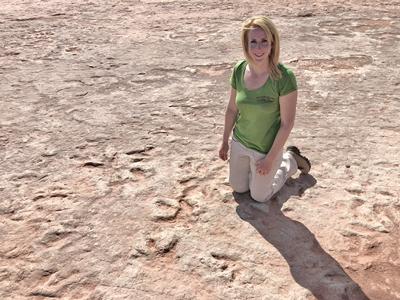Geological approach tracks deep history of planets' motions and their effects on earth's climate

Scientists have long proposed that periodic swings in Earth’s climate are driven by cyclic changes in the distribution of sunlight reaching our surface.
This is due to cyclic changes in how our planet spins on its axis, the ellipticity of its orbit, and its orientation toward the sun — overlapping cycles caused by subtle gravitational interplays with other planets, as the bodies whirl around the sun and by each other like gyrating hula-hoops.
But planetary paths change over time, and that can change the cycles’ lengths. This has made it challenging for scientists to untangle what drove many ancient climate shifts. And the problem gets ever more difficult the further back in time you go; tiny changes in one planet’s motion may knock others’ askew — at first slightly, but as eons pass, these changes resonate against each other, and the system morphs in ways impossible to predict using even the most advanced math. In other words, it’s chaos out there.
Up to now, researchers are able to calculate the relative motions of the planets and their possible effects on our climate with reasonable reliability back only about 60 million years — a relative eyeblink in the 4.5 billion-plus life of Earth.
In a new paper, published in the Proceedings of the National Academy of Sciences, a team of researchers, including Dr Jessica Whiteside from the University of Southampton, has pushed the record way back, identifying key aspects of the planets’ motions from a period around 200 million years ago.
The research team, led by geologist and paleontologist Professor Paul Olsen of Columbia University’s Lamont-Doherty Earth Observatory, compared periodic changes in ancient sediments drilled from Arizona and New Jersey in the United States. The team identified a 405,000-year cycle in Earth’s orbit that apparently has not changed at all over at least the last 200 million years — a kind of metronome against which all other cycles can be measured. Using those same sediments in the new paper, they now have identified a cycle that started out lasting 1.75 million years, but is now operating every 2.4 million years. This, they say, allows them to extrapolate long-term changes in the paths of Jupiter and the inner planets (Mercury, Venus and Mars), the bodies most likely to affect our own orbit.
The team’s ultimate aim is to use the Earth’s rocks to create what he calls a “Geological Orrery” — a record of climatic changes on Earth that can be extrapolated back into a larger map of solar system motions over hundreds of millions of years. He says it would open a window not just onto our own climate, but the evolution of the solar system itself, including the possible existence of past planets, and its possible interactions with invisible dark matter.
Dr Whiteside, an Associate Professor of Geochemistry within Ocean and Earth Science at Southampton, contributed her understanding of the expression of Solar System chaos – the ‘wobble and wander’ of planetary orbits – to the project. More precisely, Dr Whiteside looked at how changes in atmospheric CO2 affect the water cycle and how strongly the orbital changes translate into climate at the dawn of the age of dinosaurs.
“The solar system is chaotic, and precise solutions for the motions of the planets are limited to about 60 million years,” said Dr Whiteside, who is also a member of the steering committee for the next phase of coring which also involves coordination with a UK-based scientific drilling program, the JET Project.
“Using a network of coring experiments that we call the Geological Orrery (named after 18th century mechanical models of our solar system), we recover precise and accurate values for the precession of the perihelion of the inner planets from 223- to 199-million-year-old tropical lake sediments, circumventing the problem of solar system chaos,” she continued. “Extension of the Geological Orrery from 60 million years ago to the whole Mesozoic (from around 252 to 66 million years ago) and beyond would provide an empirical realm to constrain models of solar system evolution, further test General Relativity and its alternatives, constrain the existence of additional past planets, and provide further tests of gravitational models.
“Our two major coring experiments to date have taught us that changes to tropical climates from wet to dry at the time of the early dinosaurs - around 200 to 250 million years ago - were regulated by orbital cycles lasting around 20,000, 100,000 and 400,000 years with a longer cycle on top of that of about 1.75 million years,” Dr Whiteside concluded. “The shorter cycles are about the same today, but the 1.75 million year cycle is way off —it’s 2.4 million years today. We believe that this difference is caused by a gravitational ‘dance’ between Earth and Mars and represents a fingerprint of solar system chaos.”
Professor Olsen explained: “Many scientists have used sediments to determine the effects of orbital deformations. That’s how we know that the ice ages of the last few million years were paced by them.
“Some researchers have tried to go back much further in time,” he continued. “What is new here is the systematic approach of taking rock cores spanning tens of millions of years, looking at the cyclical sedimentary record of climate and accurately dating those changes over multiple sites. That allows us to capture the full range of solar system-driven deformations of our orbit and axis over long time periods.”
The paper “Mapping Solar System chaos with the Geological Orrery” (doi:10.1073/pnas.1813901116) is published in Proceedings of the National Academy of Sciences.
